BACHELOR OF DESIGN IN VISUAL COMMUNICATIONS, 2000
ALUMNI DISCOVERY INITIATIVE, INTERVIEW BY BRANDON GIESSMANN, 2015
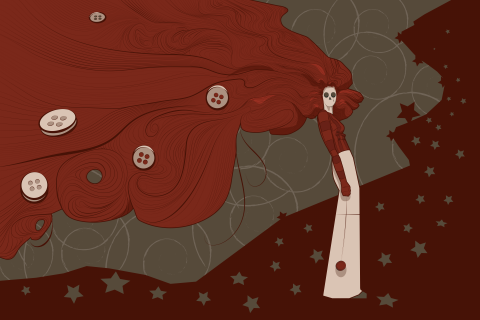
Wind and Such (2018), 8 X 12" digital print
Brandon Giessmann: When did you graduate from ACAD? (And what was it called then?) What was your major? Do you continue to work in this area or did you change areas of interest?
Michael Grills: I graduated from the Design program in 2000 with a major in Visual Communications and a minor in Illustration. I do continue to work in this area.
GIESSMANN: Awesome. Did you always work digitally then?
GRILLS: I’m the guy who was told I wasn’t allowed to work digitally but did anyway to the chagrin of my teachers. I’m that guy.
In my second year of school, Bioware released a game called Baldur’s Gate and the artwork in it blew me away. I was still trying to figure out what I wanted to do as an artist and seeing that made me want to do video games. I knew this was going to be the future and for me it was like a lightbulb went off. I knew this was it.
My whole experience at ACAD afterwards was looking at everything like, “Is this going to help me get into video games? Because if not, I’m going to change the project so it will.” It drove the teachers nuts. They had a hard time knowing what to do with me because I suddenly wasn’t as interested in graphic design and illustration in its current conceptual form as I was interested in narratives. Everything at ACAD turned into learning the basic skills that I didn’t have a good grasp on.
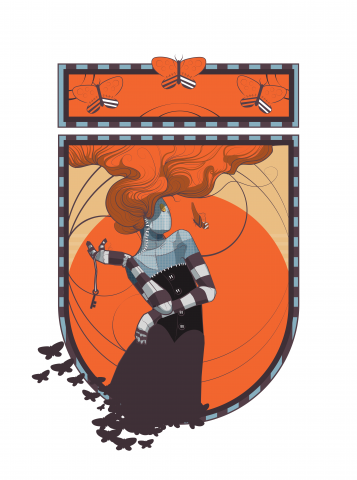
Holding Back The Key From a Butterfly (2018), digital print
When I got to the rendering class in my third or fourth year, I actually spent eight hours a day for two weeks trying to render this perfect Coke can on the computer. Now it’s something I could do in about five hours, but back then nobody knew how to do it. There were no instructions or tools, so I was experimenting. I brought it to class and it looked real, it looked like a photograph. Everyone else had done watercolour paintings of these cans and when I got my mark it was a C+ while the paintings were getting A’s and A+’s. I couldn’t believe it. I went to the teacher and told him I didn’t understand the mark at all and he said, “Well you used a computer. Didn’t you?” I said yes. He replied, “Well there’s programs out there now that will do this for you.” I explained to him that I did this by hand and I spent two weeks on it and he said it didn’t matter, he couldn’t change my mark because I used a computer. What was interesting about that project is when two art directors from Bioware came down, that was the project that got me the job with them.
GIESSMANN: A lot of graduates use the ACAD degree as a creative stepping stone. So, what do you do? How has what you do evolved since graduation? How did your education at ACAD direct your career?
GRILLS: I have a business. I do freelance illustration for everything from doing storyboarding for video, making final assets for video games, doing magazine editorials, and animation. I do the whole gamut of what you can do in illustration.
It’s part of being in Calgary and not just being slotted into a corner and forgotten about. You have to take on a lot of different roles. I art direct, I’ve written scripts for video games, and I’ve written scripts for movies. I’ve also been on strategic teams for startup companies. You end up covering wherever needs to be covered. People like me don’t really have the ability to one hundred percent specialize, even if we’re known for a speciality. It’s very hard to do that. You sort of go wherever the project is, and if you’re like me you go to where the most interesting ones are.
For me there was a project I was given in my third year at ACAD that made me realize who I was. It was a graphic design and marketing project; we were supposed to understand who our target audience was for a product. I had chosen foldup bikes, and I wasn’t getting it. My teacher told me I wasn’t understanding who my target audience was, and finally he gave me the answer.
The problem was that I was looking at the product like an economic item, a commodity, but it was actually a product for people looking for adventure, and who need to move quickly. As soon as he pointed that out to me, I started looking at adventure magazines and diving into that audience. Then I realized I was the audience: my life was not going to be mundane; it was going to be an adventure. This was part of the reason I went to ACAD in the first place. I wasn’t interested in the everyday. For me the stepping stone of ACAD was setting my life up to be an adventure.
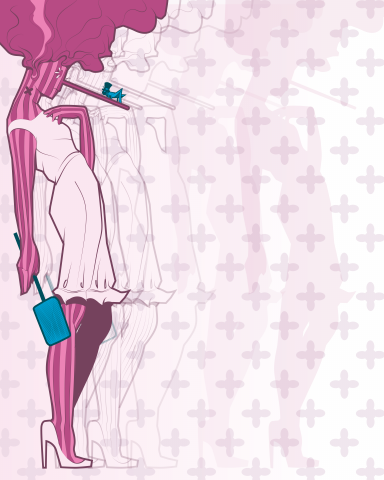
Shut Up Cricket (2018), 8 X 12" digital print
Where I separate from a lot of artists is that [being creative] is a very zen thing for me. I’m searching for the biggest adventure. I’m never looking for the most money or the accolades that may come with a certain project. I’m always asking, “Where is this going to lead me? What am I going to learn? What am I going to discover about myself and other people?”
GIESSMANN: What would you like to be recognized for?
GRILLS: I always struggle with this question when people ask me. I guess for being fearless… at the end of the day that’s what I’d like to be recognized for. Just a fearless creative who is interested in taking it on. I think I came to that answer just now, but I’ve been struggling with it. I feel proud when people tell me they wouldn’t have the guts to do what I’m doing. I can understand why people feel that way because I grew up in a very practical family, where the idea of becoming an artist was insane. I had siblings who were always egging each other on, and it was all about who could do the most crazy thing.
For me crazy was being an artist. It’s a path on which you have to really distance yourself from everything that comes with it. You have to be fearless in the sense that everybody, including other artists, is going to tell you that you are crazy. You’re kind of in it by yourself. I’m always looking for other fearless people to work with and finding them are my favourite moments. When I’m around a group of fearless creatives anything can happen. It’s amazing. Fearful creatives tire me out, they really wear me down; creatives who are just looking for a job or think awards are the answer. They’re very narrow-minded about what they can be or what they can contribute.
GIESSMANN: Given your experiences, what advice would you give a student when it comes to establishing a creative business?
GRILLS: You need to ignore everybody. I mean it. Everybody. Nobody knows what they’re talking about. We live in an age right now where there is no such thing as the right way to do anything. There is no right way. If something works for one person, it will not work for another. It’s just the way it is right now. I believe we are coming very close to a time where cottage industry is going to take over our entire economy. Even accounting has changed; not the rules, but how people get through it.
The laws of copyright are changing again because nobody knows what to do. If you could have predicted ten years ago that mashup culture would be the ultimate culture, which is what we’re living in right now, people would say you’re insane. The fact of the matter is our culture celebrates when you take two unique things and mash them together, especially if they don’t make sense, but you somehow find a way to make them make sense. It’s our number one celebrated theme. It’s going to disappear because eventually people will get bored, but can you predict what’s coming? You can’t. You might be a part of it as a student or you might miss it completely.
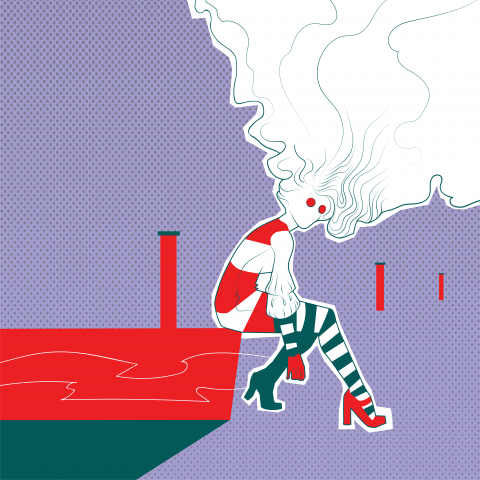
DigiWhim (2018), 12 x 12" digital print
I was lucky, I predicted video games. I said, “This is the next big thing” and everyone told me I was crazy. Lo and behold, 15 years later I still do the odd video game. I know that without them, my illustration style and career wouldn’t be what it is today. You can’t let other people tell you you’re wrong. If something makes sense to you, it’s going to make sense to somebody else and they’re going to recognize that. You have to go with it.
Watch trends. My dad gave me that advice when I was fourteen and said, “If you can spot trends you will always be fine.” Even if you don’t want to take part in the trend you need to recognize that it’s happening so you can take advantage of it, or work around it.
Rely on your art fundamentals. They will take you so far. After you finish school get back into books about composition, line, light, all that sort of stuff, and study. Never stop learning, because while I stress merging creativity and technology, that still doesn’t account for taste. Taste can be learned through these fundamentals, though. You’ll see it. There’s a difference between something that’s tasteful and something that just exists. Taste will beat out technology eventually every time, and that’s where we excel as trained creatives.
Stop seeking approval, even from your clients. My success didn’t happen until I started telling clients their answer instead of seeking their approval, even to the point of losing some of them because of it. Those clients were anchors, holding me down. They were not helpful for a creative career.
My world changed when I started saying, “This is what you want. This is what you need.” A client will see you as a set of hands and you have to blow that misconception out of the water as soon as possible. You have to show them that you are a trained creative. As soon as you do that, they’ll start to rely on you. I have clients who don’t even ask, I just do it. When you first start out that’s obviously not going to happen, but if I had initially had more faith in what I was doing I would have struggled less with the idea of [clients] accepting the work. Don’t take it personally if it they don’t accept it. When someone doesn’t accept something, who cares? It’s going to be so hard at first but just keeping moving on.
GIESSMANN: What insights did your years at ACAD give you when looking at things?
GRILLS: I still rely on the fundamentals and my ability to conceptualize ideas from nothing. That’s an ACAD trained skill. About seven years ago, I realized when I was in a room with a bunch of people trying to come up with an idea that I could see things nobody else could. That came from ACAD. Being forced through that process over and over again, and being encouraged to look at things multiple ways. That’s how you find what is deeper. It’s a tool I use all the time.
At the end of the day I end up doing a lot less work than a lot of people for an idea because I’ve already looked at it ten different ways. There’s huge value in that and people really appreciate it. That’s what makes an ACAD educated employee stand out. They’re always moving forward.
GIESSMANN: After graduation, what obstacles did you encounter and how did you overcome them?
GRILLS: Every industry has its bullies. I had to deal with two really strong personalities coming out of school. I witnessed a lot of fighting, saw a lot of people trying to make their mark, and had to deal with poor management, while trying not to get bullied without coming across aggressive myself.
One of the reasons I struggle with recognition or accolades for anything is that’s where a lot of those obstacles were coming from. People needing to be recognized, wanting to be mentioned in the news and stepping on others to get there. I didn’t want to be that type of person. At the end of my life, I’m more interested in who is at the funeral than what is hanging on the wall. For me it was a struggle to witness that, even as someone who wanted to be recognized. I just refused to do it that way.
That ended up causing me to leave Bioware and really doubt my own abilities. To overcome that, I won some awards to reaffirm my knowledge and confidence in my skills. Then I set some goals: setting up a number of projects for clients and starting up a creative business. Now here I am in my eighth year of doing that, and it’s more important to me than any of that other stuff. I think when you come out of a school you have to deal with a lot of competition. How you handle it will be what you’re recognized for.
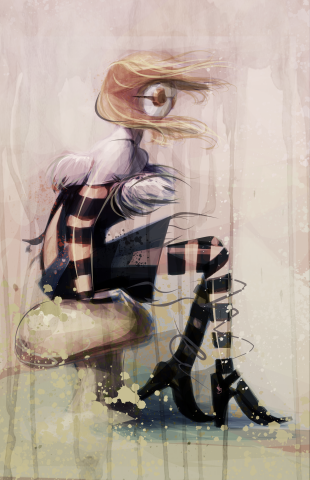
Muffet (2017), 13 X 18" digital print
GIESSMANN: How could you imagine ACAD supporting our alumni?
GRILLS: I would like to see ACAD celebrating the entrepreneur. The unknown visionary. Every time I’m on the ACAD website they’re always mentioning the names of people who are working for already established brands as though that’s important, and it is, but the driving force of creativity is not somebody who is now working for Mercedes or Apple.
The creativity that is happening in this city is unbelievable, it’s magic, but it’s almost all underground and ACAD needs to acknowledge that. We want to talk about economic growth? It’s in that underground that it’s going to happen. It’s not going to happen in those established brands… that’s just a job.
It’s about recognizing the people who are taking the risks, who are creating a trend that nobody is going to recognize for ten or twenty years. It’s a difficult thing for ACAD to do, to back that up, because they’re having trouble seeing it. It’s like how we continue to celebrate entertainment as artists after the fact, after they are done. We’re not celebrating them at their prime, when that’s really what it is about.
GIESSMANN: Why do you think that creativity matters in the big picture?
GRILLS: Liberal arts graduates in the United States are the highest employed by degree. You’re more employable than someone with an engineering degree. That’s just the current state of things. The reason you’re more employable is because you think outside the box, you’re not just there to do your job; you’re there to add more. I think creative people can’t help but do that. That’s why it matters. Creative people add value where other people don’t even see it.
We have an opportunity now with those statistics and with that proof to start to be a voice to support that. We need to start creating a dialogue with the people who can help make that change. We need investment in creativity. The only people who are currently complaining about the state of affairs are modern industries like film, video games, and the startup world. You don’t hear the artistic voice in there and we need to bond with those people so we can be a part of that conversation. We need to keep looking forward and stop looking backwards.
Tradition is a place to learn from, it’s not a place to hang out; nobody cares. Tradition is a hobby, it’s not an art movement that moves things forward.
GIESSMANN: Where does art fit into your future?
GRILLS: I’ll never stop. It’s an adventure. I’m starting to paint more but I don’t know where that’s going to lead. I’m not too concerned; I’ll keep my eyes open. I don’t think I could stop. I made an attempt [to stop] a year ago and what’s interesting is everyone else is struggling to be creative, so why would I give it up? The trained creative is so valuable. I’ll always be in that space, whether I take on more of a consulting role in the future or more hands-on. Perhaps becoming a voice for the people out there taking risks.